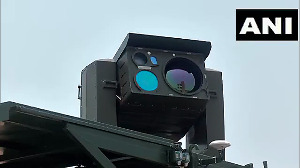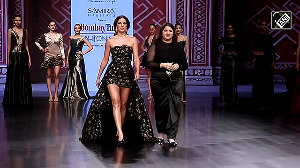
The uniforms worn by the Indian contingent at the Paris Olympics opening ceremony have ignited a firestorm of criticism, with many questioning the design's representation of India's rich textile heritage.
The saris, in particular, have come in for much criticism.
The outfits were designed by Tasva, the Adita Birla Group brand, for which renowned Designer Tarun Tahiliani is the chief design officer.
Tahiliani has faced a barrage of criticism on social media, with users comparing the sarees to cheap polyester garments and accusing him of disregarding India's textile legacy.
Social media also erupted with disapproval over the choice of fabric, the use of ikat prints and the overall aesthetic, with many deeming the design unimaginative and unrepresentative of India's textile legacy.
Did you like the Indian uniform at the Olympics opening ceremony?
'Hello Tarun Tahiliani! I have seen better sarees sold in Mumbai streets for Rs 200 than these ceremonial uniforms you've 'designed',' author and food and health writer Dr Nandita Iyer tweeted on X.
She called the outfits a combination of digital prints, cheap polyester fabric and the Tricolour thrown together without any imagination.
Actor Tara Deshpande said, 'They look absolutely awful. We have the greatest textile tradition in India. Who passed this design? Who budgeted for this?'
Jai Anant Dehadrai, a Delhi-based criminal lawyer said on X, 'The Tarun Tahiliani designed outfits for the Indian Olympic contingent are a total embarrassment -- even more shameful is the unabashed promotion of his own commercial logo on the uniforms.
'This is unacceptable -- the bureaucrats responsible should have invited traditional Indian designers and weavers to come up with the best of Indian textiles and design for our sportspersons -- not this unimaginative, and tacky rubbish.
Novelist N S Madhavan tweeted, 'At the world's fashion capital, an Indian athlete looked like this -- dull and ordinary. Tarun Tahiliani's mix of plastic-sheet-like saree, printed ikat and unimaginative use of tricolour, shut the window to the splendorous world of Indian textiles.'
Shutter and Arjuna Awardee Jwala Gutta tweeted her dismay. 'The garments which was made for the Indian contingent participating in Olympics this time has been a huge disappointment!! (Especially when the designer was announced I had huge expectations),' she said.
'First not all girls know how to wear a saree…why didn’t the designer use this common sense and make a pre-draped saree (which is in current trend).
'The girls looked uncomfortable the blouse was of bad fit!!
'And second the colour and the print was so opposite of beautiful Indian!!! There was an opportunity for the designer to display the art of our culture through embroidery or hand paint!!
'It was a work of absolute mediocrity and looked shabby!!!
'I really hope the sports family stops compromising on quality for our sportspersons looks on court and off court!!!!'
Author Anuja Chauhan wanted to know: 'Why are our Olympians looking like Congress Party workers?'

Tahiliani, in an interview with The Indian Express newspaper, defended his design choices.
'Paris can be boiling hot in July. The choice of viscose over cotton was deliberate. Cotton would have crushed badly. We used viscose because it is a wood pulp fibre and lets you breathe. It is cooler than silk. We had to consider breathability because the athletes would be on a barge, in the heat, for up to five hours.'
He added that the silhouette for the men included the 'Bundi jacket' while the women wore 'pre-pleated saris'.
'They are not only comfortable and functional but also represent a fine balance of tradition with modernity. It would have been easy for me to send them in zardozi vests but that choice is not appropriate for the occasion,' he told the Indian Express.
Explaining the need to use digital prints instead of the original Ikat weave, he told the newspaper, 'Yes, we used prints because we can't weave in three weeks for a 300-member team. It's so ridiculous to expect that. Only the shoes were brocade from Banaras.'
Speaking to NDTV, the designer said, 'This is what we Indians wear and this is not meant to be a couture show.
The design, he added, was meant to ensure that the colours of the Indian Tricolour could be clearly seen from afar as well.
Tackling the accusation of incorporating the Tasva logo in the design, Tahiliani told The Indian Express, 'There was no logo. There was a symbol that was made into a border, that's all. And when you see the photograph, you won't even notice it. We had originally put the Indian flag but were told one should or could not use it.'
Putting in a final word, he said, 'I stand by my design. Perhaps it is time to focus on what really matters and that's sport. In the end, our athletes looked good, supported the Tricolour and were cohesive and cool. It's not a wedding. It's sport.'
However, his explanation failed to quell the growing discontent.
Following the outpouring of criticism, Tasva -- the brand that created the outfits -- issued a separate statement:
'We at Tasva by Tarun Tahiliani are aware of the comments doing the rounds but would request your consideration and support on the following.
'We did not aim for haute couture; our focus was on creating functional and comfortable uniforms for our athletes. We are proud and gratified by the positive feedback we've received, especially from the athletes themselves."
'We recognise that in a diverse country like India, opinions will vary, and we welcome all perspectives. Our ultimate goal remains to represent India with dignity and pride on the global stage.
'We at Tasva feel that the best way to represent the country is the Tricolor. And we feel that when the athletes wore the Tricolor designs and sailed past the Seine river, it was a powerful imagery and a very proud moment for all us Indians.'
Susan Thomas, former director of the National Institute Of Fashion Technology, Bengaluru, was one of the few who lent support to the bealugured designer.
'I woke up to the pictures of raincoat clad Indian contingent in the opening ceremony of the Paris Olympics which decided to break the tradition and hold it in boats in a floating parade in Seine. Since a lot has been said and written on their uniforms, I thought I will offer my two drops into the river,' she said on Instagram.
'Viscose: Long back, I watched the wonderfully articulate @behavebandana (Bandana Tewari, lifestyle journalist and sustainability advocate) talk about the carbon footprint of cotton as it is a water guzzler. Viscose is a regenerated cellulosic fibre and given that it dries in a matter of minutes must have been a top consideration for the uniforms where you dont want the players to get wet in the rain given it is Olympics -- a performance driven event that hinges on fitness.
'I headed two teams in our uniform design projects @nift.bengaluru and neither of them was handloom. Concerns were many, shrinkage and high maintenance for one.
'Many moons back, in my naivete, I had asked the Indigo airline honcho to introduce an element of ajrak in their uniform and he said 'impossible'. Performance textiles, easy to maintain fabrics, fuss free stuff.
'I have been writing on textiles and handloom in this space for more than 5-6 years and what I have realised is that the binary narrative and the shrillness with which we advocate it is completely misplaced and lacks understanding of the ecosystem of a uniform design or handloom space.
I met @kausalyasatyakumar (design manager, Taneria, Titan) for coffee at Bengaluru and having worked for many decades with weaving clusters and now corporate, K and I had the same things to say.
'We need to free ourselves from the messiah mode of saving weavers and weaves. Youngsters in the weaving cluster do not want to take it up, the demand is huge and the supply chain is weak and tottering.
'Let Olympic sports be not saddled with the weight of representing handlooms.'












 © 2025
© 2025